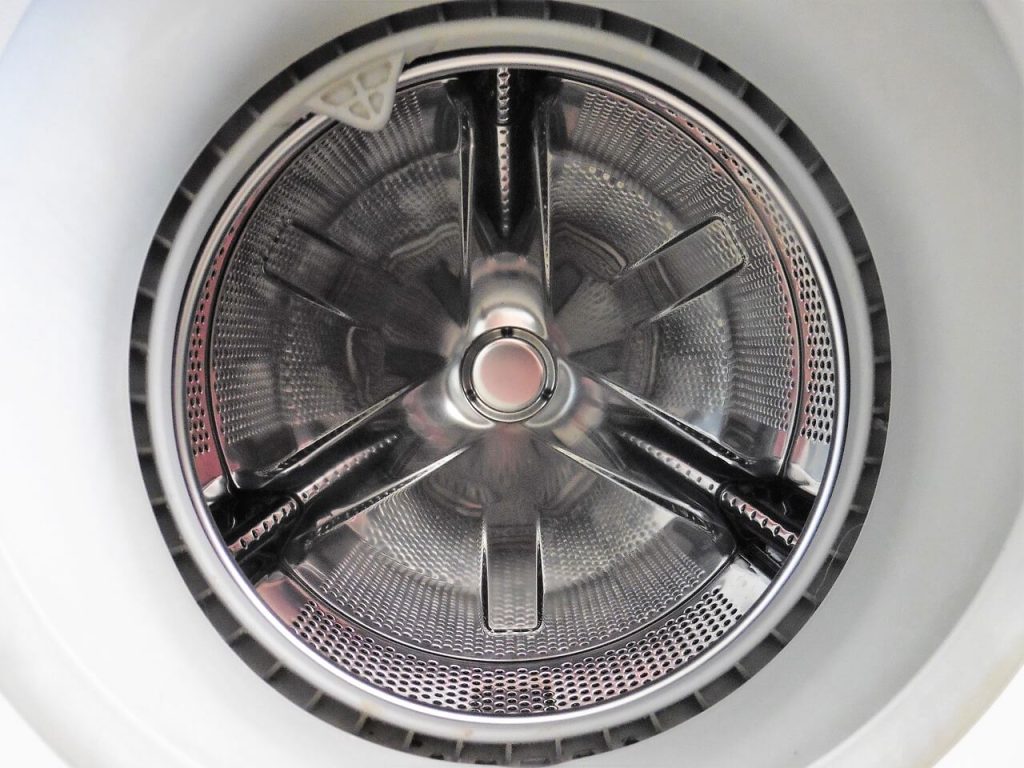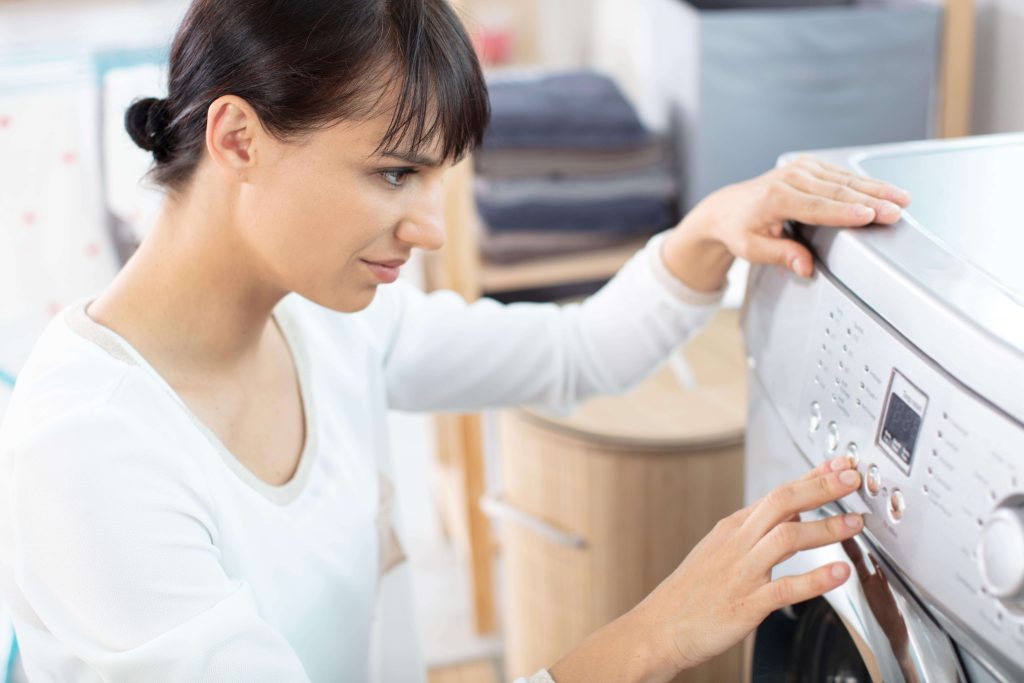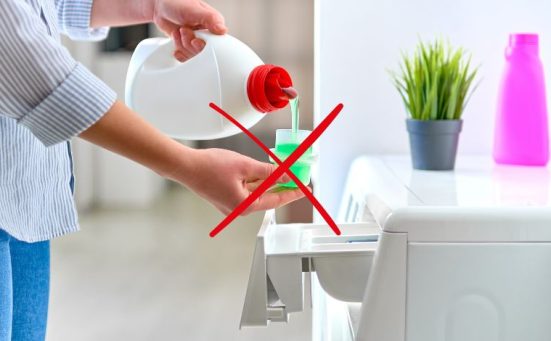
What You Need To Do When You Get A New Washing Machine
It’s a great feeling when you get a brand new appliance and although washing machines are relatively easy to use, there are a few things that you have to do when using a new washer for the first time. Finding out the correct way to use your new washing machine can go a long way towards keeping the appliance running properly for many years to come.
So if you’ve just had a new washing machine delivered and you want to know exactly how to use it, keep reading.
Things You Need To Do As Soon As The Washer Is Delivered

There are a few things that need doing just as soon as the new washing machine arrives. Which include;
Inspect The Packaging
As soon as the new washing machine arrives it can be such an exciting time that you might forget to check the packaging. This is an important step because it can easily help to determine the chances of the appliance having been damaged in transit.
If there are visible signs of damage to the packaging like rips or tears, it’s pretty obvious that the delivery team weren’t taking good care of the washer whilst it was in their care. It could have been damaged in the delivery van either by poor handling or it might not have been stacked correctly and has been damaged by moving around on the journey.
99 out of 100 washing machines arrive with no visible signs of damage to the packaging, but you should still make sure. If you do notice any signs of damage to the packaging, it’s a good idea to take a few photos as proof.
Inspect The New Appliance
Once all of the packaging has been removed, it’s just as important to check the body of the appliance over for any dents, scratches, marks, etc. If you find any contact the seller and let them know. Take a few photos and send these as well to prove that you’re not just being picky.
Let’s face it, washing machines aren’t cheap and you don’t want a damaged model unless you’ve bought a second grade appliance or showroom model. Even if the marks are in an area where they won’t be seen, a brand new appliance should be spotless.
You then need to ensure that all of the parts are there. Your new washer should come supplied with all of the relevant hoses etc needed to get it working straight away.
Once the delivery crew have left, it’s going to be difficult proving that certain detachable parts were missing.
Read The User Manual Thoroughly
Even if this is your fourth or fifth brand new washing machine, or the first one you’ve ever bought, you should always read the user manual from cover to cover. Every brand and model are different so you can’t assume it will work in exactly the same way as your old one.
Plus, if it is your first washing machine, the user manual will take away all of the mystery and allow you to understand how it works right from the start.
Washing machine user manuals are typically not that long and are split into various sections which make it easier to understand what’s going on. You will also find a section on “dos & don’ts” designed to give you a brief insight on the best ways to use your new machine.
Remove The Transit Bolts

All new washing machines come fitted with transit bolts. They are put in place to prevent the drum from moving around during the journey from the factory to your home.
This prevents any internal damage to the components of your new washer. However, if you leave the transit bolts in place and try to use the washer, you will cause even more damage and render your new washing machine useless.
Added to which, if you were to use your washer with the transit bolts in place, and the machine got damaged, you wouldn’t be covered on the warranty. This is because the warranty only covers faults due to manufacture and not negligence on the part of the user.
Your user manual will show you where the transit bolts are located and how to remove them. There will be two, three or four transit bolts in place and they can be removed with a spanner.
Don’t throw the transit bolts away because you may need them if you move home and take the washer with you.
Plumb The New Washer In
You obviously can’t skip this stage in the proceedings because without plumbing in the washer it won’t work. If it’s your first time it can seem quite daunting and if you’re really unsure of your DIY skills, you can contact a plumber to install the washer for you.
Many appliance retailers offer this service at a small charge to make life easier for their customers. However, it is a relatively easy task as long as all the relevant pipe work is already in position.
Follow the instructions in the user manual or scan the QR code which will typically take you to a video showing exactly how to plumb the appliance in. Or call in a local plumber to fit the new machine up for you.
If you ask them nicely they might even show you how all of the features of your new machine work. However, this is no substitute for reading and understanding the user manual.
Register Your New Washer’s Warranty
You will probably already have noticed a large sticker on the front of the washer reminding you to register it to activate the warranty. You should do this immediately because it will give you cover for an extended period.
This means that if the washer were to break down or a particular part developed a fault, the problem would be solved under the warranty and you wouldn’t have to pay for it.
Also if you register immediately, you might get an extra year’s cover for free. Many companies offer this but there’s often a cut off point which is why it’s important to register the appliance as soon as possible.
Run An Empty Cycle

Before you put any laundry in your new washing machine, you should run an empty hot wash cycle. This will help to remove any dirt or other debris left behind during the manufacturing process.
There might be the odd patch of grease or some minute metal shavings that could potentially cause problems for your wash load if not removed first. While the cycle goes through its stages, you can take the opportunity to check that there are no leaks from any of the hoses or connections.
You can also get to know the sound of your new appliance which could be invaluable if there’s ever a problem with the appliance. You might notice that it sounds distinctly different to normal, giving you a warning that there’s something wrong.
How To Use Your New Washing Machine

Now that you have set your new washer up and checked that it is working correctly and all dirt or detritus from the manufacturing process has been removed, it’s time to do your first wash load. This also involves a few steps that should be followed. Which include;
Go Through The User Manual Again
I know this sounds like overkill but, when you first read the user manual, you were focussing on installation and set up. Now, it’s all about programmes, cycles and other operational procedures. You need to check up on the following;
Cycles
All new washing machines will have a selection of cycles you can choose for different types of fabric and temperature settings etc. Your new machine could have more or less cycles but most typically have the following;
- Quick Wash
- Cotton
- Synthetics
- Delicates
- Hand Wash
- Hot
- Cold
Plus a number of temperature settings ranging from 20o C up to at least 60o C with many including a 90o C cycle. Once you’re aware of the wash cycles available to you on your new machine, you’ll be able to select the right one for the clothes in your laundry pile.
Weight Capacity
The weight capacity of your washing machine refers to how much weight you can safely put of dry laundry into the drum. This is really simple to get your head around once you understand what it all means.
The weight capacity is typically measured in kilograms and you will have selected a washing machine with enough load capacity to suit your needs. The sales team would have advised you on the most suitable weight capacity for your home.
Modern washing machines have weight capacities ranging from 5 kg up to 12 kg. This means a 5 kg washer will have a smaller drum size than a 12 kg washer.
- Overloading
This is because it is designed to wash a smaller amount of laundry. However, there’s more to it than that. It is recommended that you never fill the drum with more than ¾ of the maximum capacity it can hold.
For instance, you should never put more than 6 kg of dry laundry in an 8 kg drum. This will help prevent any damage to the drum from overloading and ensure that each item gets washed properly. - Underloading
However, underloading the drum can be just as bad because it can cause the drum to be unbalanced. This will mean that all of the weight will be concentrated on one side of the drum which can lead to damage to the bearings, the drum and other internal components.
It is recommended that you never wash a load of less than ½ the drum capacity. So using our 8 kg washer as a guide, that would mean never washing less than 4 kg of dry laundry.
Don’t worry too much about weighing your laundry as you can tell how much has been put in by looking at the drum. Try to always fill the drum to at least the halfway level and no more than the three quarters level.
For more information on washing machine capacity follow this link.
Sort Your Laundry Into Separate Piles

Before you wash your laundry it’s important that you sort it into piles. I know this can be time consuming but it is important for a number of reasons. Which include;
- Different Fabrics Need Different Settings
You need to check the wash care label on each item and sort the laundry into piles that can be washed together. Delicate items can’t withstand the same conditions as cottons for example. - Colours Can Run Onto Other Garments
You should wash items of a similar colour together to prevent colours from bleeding onto other garments. The white wash needs to be separate from the coloured wash for example. - Heavy Stains Need Separate Treatment
If you notice a garment which has been stained it may need to be soaked or pretreated with a stain remover. Otherwise the stain might not get lifted out during the wash cycle. Plus the contents of that stain could leak onto other items if not treated first.
Starting A Wash Cycle
Once you’ve sorted the washing into separate piles, and you’ve studied the user manual, this next bit will be easy.
All that you need to do is select the correct cycle for the wash load you have put in the machine, add the correct amount of detergent (consult the packaging for the correct amount to use), select the most suitable temperature setting, ensure the door is closed correctly and press start.
What To Do After The Washing Machine Finishes

Once the cycle has fully completed, you will need to allow a couple of minutes for the door interlock to cool down before you can open the washer’s door. Once you have got the door open, remove all of the now clean laundry and put it in a wash basket.
Whilst transferring the laundry to the wash basket give each item a quick look over to ensure it has been cleaned properly.
Getting The Laundry Dry
The wet clothes need to be dried as soon as possible to prevent them from smelling damp and musty. This can also lead to black mould forming on the clothes so it’s imperative that you get them dry as soon as you can.
There are a number of ways you can get your clothes dry which include;
- Using a tumble dryer
- Using a clothesline
- Using a clothes airer or rack
- Using a heated airer
Once the clothes are drying you should check that the drum is completely empty and you haven’t left any clothes behind.
Check The Machine
Now that the machine is empty, you should wipe around the door seal to remove any excess water. You should then inspect the hoses and connectors to check there are no leaks.
Then check the display screen to see if there are any error codes displayed that would indicate that the machine has diagnosed any problems. You will need to consult your user manual for the interpretation of any error codes if they have been displayed.
Or check online for the relevant information or contact the manufacturer. In all honesty, there’s not much of a chance of an error code being displayed after the first use of a new washing machine.
How To Maintain A New Washing Machine

There are a few little jobs that you can do to ensure your new washer keeps working as it should. These include;
- Remove & clean the filter every two months
- Clean the detergent dispenser drawer every month
- Run a hot service wash with an empty drum every month
- Always wipe down the rubber door seal after every use
- Leave the washer door open as well as the detergent dispenser drawer after every use (this prevents mould and mildew from forming)
Why Does A New Washing Machine Have Water Inside Before Use?
If your new washing machine has water inside before you use it, this is nothing to worry about. It is because your new washer has been tested in the factory before being shipped out to you.
The water is the remnant of that test and simply never had enough time to dry out before the washer was sent to you.
SEE ALSO: Do I Need To Run A New Washing Machine Empty First?
Frequently Asked Questions
The reason your new washing machine takes so long to finish a cycle is because modern washers are designed to use less water and be more energy efficient. This means the laundry needs to soak for longer to get the clothes clean.
The first thing you should do with a new washing machine is inspect for damage. Then you need to remove the transit bolts before plumbing the washer in. You should then run a service wash with an empty drum to remove any dirt left behind in the factory.
You can use your new washing machine straight away, but it is advisable to run a hot service wash first with an empty drum to ensure there is no manufacturer’s grease or dirt left in the appliance.
It is not uncommon for a new washing machine to have water in it. This is because the washer was tested in the factory before being shipped to you.
Also, follow us on Pinterest ...



